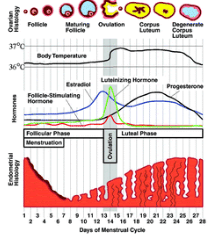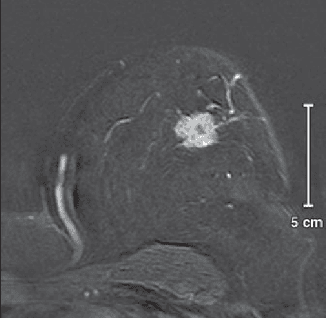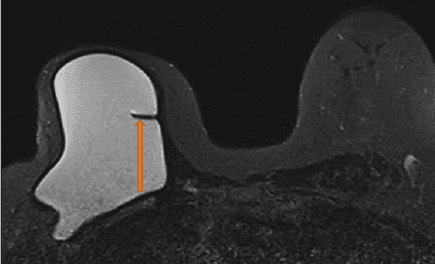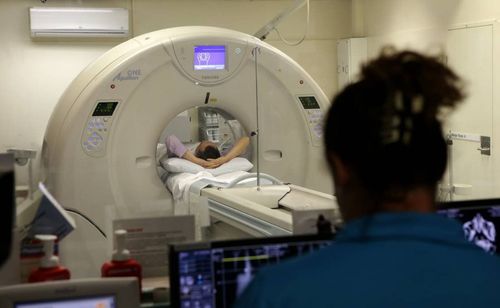This is an automatically translated article.
Posted by Master, Doctor Nguyen Le Thao Tram - Doctor of Diagnostic Imaging - Department of Diagnostic Imaging - Vinmec Nha Trang International General Hospital
Magnetic resonance mammography is a modern imaging method that uses magnetic fields, radio waves and computers to create detailed images of the breast. This is a technique to help screen, diagnose and monitor the treatment of breast diseases. So when is the right time to have a mammogram?
1. An overview of mammography
As breast magnetic resonance imaging (MRI) becomes a more widely accepted modality for breast cancer screening in high-risk women, hormone status and menstrual cycle are imaging considerations. important photo.
In most cases of breast MRI, the use of contrast (or contrast) is quite common. Because contrast agents make a great contribution to the identification and classification of lesions based on the difference in enhancement compared with the background tissue as well as their drug-adherence properties.
2. Timing of mammography in women with regular menstrual cycles
The ideal time for an MRI of the breast is approximately between the fifth and 15th days of the menstrual cycle. Because during the luteal phase of the menstrual cycle (from the 15th day onwards), an increase in the hormones estrogen and progesterone causes swelling and development of the lobes. This leads to an increase in breast tissue enhancement during the luteal phase of the menstrual cycle, up to seven days before menstruation. Therefore, breast MRI should not be performed during this time, but instead, between days five and 15, long enough after the luteal phase to reduce any false-positive background tissue enhancement.

Hình 1: Giai đoạn hoàng thể (Luteal phase). Hình ảnh mô tả sự thay đổi thông qua chu kỳ kinh nguyệt của các hormon chính liên quan, nhiệt độ cơ thể và độ dày nội mạc tử cung tương đối. Giá trị trung bình được hiển thị; thời lượng và giá trị có thể khác nhau giữa những người phụ nữ khác nhau và những chu kỳ khác nhau. ( Nguồn tham khảo: commons.wikimedia.org)
3. Timing of mammography in women with irregular menstrual cycles
One limitation of breast MRI in premenopausal women is that hormonal fluctuations during the menstrual cycle have caused an increase in gadolinium enhancement in normal breast tissue that makes it difficult to evaluate MRI images. more difficult.
Or some women do not have a normal menstrual cycle to determine the optimal time to have an MRI scan, for example, premenopausal women who have had a hysterectomy but still have normal functioning ovaries. premenopausal women with irregular menstrual cycles due to oral contraceptives or injections; premenopausal women undergoing induced chemotherapy with perimenopausal conditions and perimenopausal women with irregular menstrual cycles. Therefore, if a breast MRI is performed at a time interval that corresponds to the luteal phase of the menstrual cycle, gadolinium uptake may cause false-positive results on MRI or even mask an enhanced cancer. minor abnormalities, leading to false negatives.

Phụ nữ có chu kì kinh nguyệt không đều sẽ khiến hình ảnh MRI trở nên khó khăn hơn.
Therefore, a number of studies have hypothesized that serum progesterone levels could be used to enable appropriate breast MRI for women in the corresponding follicular phase of the cycle. menstrual cycle (author Delille - 2005, author Richard L.Ellis - 2009). In which the author showed that progesterone levels ≤ 1.5 ng/mL (≤ 4.7 nmol/L) correlated with the follicular phase (days 3 - 14) during the normal 28 days of the menstrual cycle. These studies help determine better timing of breast MRI for a population of women who do not have regular menstrual cycles.
4. Magnetic resonance mammography in breast implant evaluation
Breast magnetic resonance is the best means of determining whether a patient has a ruptured breast implant or not. The special pulse sequence of the magnetic resonance will help evaluate the breast implant shell, determine the status of silicone in and out of the capsule (if any).
However, contrast is not necessary when only breast implant integrity is to be assessed. Contrast should be used only when the characteristics of adjacent tissue need to be evaluated to consider neoplasia.

Hình 2: Hình ảnh MR các mức độ ngấm thuốc mô vú (A) tối thiểu, (B) nhẹ, (C) trung bình và (D) mạnh. (Nguồn tham khảo: semanticscholar.org)

Hình 3: Tổn thương BIRADS 5. (Nguồn tham khảo: researchgate.net)

Hình 4: MRI vú đánh giá túi ngực, không dùng thuốc đối quang từ.
Breast MRI plays a huge role in breast cancer screening. This technique is one of the techniques used very effectively in the Breast Cancer Screening Package at Vinmec International General Hospital. In addition to breast MRI, Vinmec also deploys other techniques such as histopathological diagnosis, gene-cell testing, .... to have the most complete basis to accurately determine the customer's health status.
To register for examination and treatment at Vinmec International General Hospital, you can contact Vinmec Health System nationwide, or register online HERE
References:
Greenwood. M.B. (2009), Breast MRI: All about timing, Imaging technology news, Sep 2009. Ellis R. (2009), Optimal Timing of Breast MRI Examinations for Premenopausal Women Who Do Not Have a Normal Menstrual Cycle, AJR 2009, 193: 1738 – 1740. Wiedenhoefer. F.J. (2015), MR imaging of breast implants: Useful information for the interpreting radiologist, Applied Radiology, Oct 2015, p18-24.














